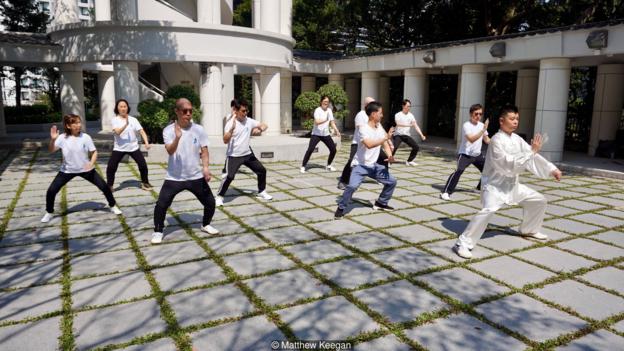It’s early morning in Hong Kong. As the roar of traffic and rush of the commute begin, the city moves to its usual pulsing rhythm. But in the heart of one of the most hectic urban jungles on Earth is an unlikely garden of calm and healing – a little oasis where the pace is decidedly slower.
Located in Hong Kong Park, a lush green space in the centre of the city, is a dedicated tai chi garden. Designed with a courtyard for practicing, and decorated with bonsai trees, it has a serene quality that comes as a pleasant surprise in an area otherwise dominated by skyscrapers and the rush of city life. The garden is used frequently, if not daily, as locals gather in parks like this across the city, mostly in the morning, to practice the centuries-old martial art.
It’s here under the early morning light that a group of tai chi students, led by their teacher, Master Chow, are using the garden as their classroom. They run through what’s known in tai chi as a “form” – a sequence of fluid moves.
To an observer, the movements appear effortless. The students glide and flow seamlessly from one move to the next, exuding a calmness that’s far removed from the bustling streets nearby. Passers-by stop and watch, momentarily soothed by the movements that, although gentle, cut a powerful presence.
“People think that tai chi is just soft. But it’s all things – gentle, explosive, delicate, calm and full of wisdom,” said Chow. “There are 1,000 words to define it, but there are no words to fully describe it.”
Tai chi is a type of ancient Chinese martial art that is widely believed to have originated more than 400 years ago during the Ming dynasty. Chen Wangting (1600-1680), a local military commander from the Chenjiagou village in Henan Province, has historically been recognised as the first person to create and practice tai chi. After retiring from the army, Wangting created tai chi as a fighting art to protect his family against thieves and bandits. He integrated the skills of different martial art styles with elements of the Taoist yin-yang philosophy – the idea that everything consists of two opposing forces that harmonise with each other to create a whole – as well as theories drawn from Traditional Chinese Medicine.
Nowadays, tai chi is mainly practiced as a low-to moderate-intensity exercise combined with meditation, body awareness, imagery and controlled breathing. Its main objective is to achieve longevity through mind and body conditioning.
Tai chi maintains cardiorespiratory function, muscular fitness and joint flexibility
The ancient practice is immensely popular throughout China, but it is particularly beloved in Hong Kong for its ability to relieve stress and improve health. With famously small living spaces in Hong Kong, going to the city’s parks or tai chi gardens is a good way to be out in the open while getting some exercise. Hong Kong also has a rapidly ageing population – about one third of its population will be aged 65 or above by 2038 – and the city’s elderly citizens are encouraged by the government to attend classes in the morning, which are often followed by tea and dim sum with their teacher and classmates. Not only do tai chi classes promote healthy movement, but they provide the elderly with a social community and combat isolation.
Some experts point to the health benefits of tai chi as a reason lifespan has increased in Hong Kong over the last 50 years. Hong Kong has the highest life expectancy in the world. Women in the city live, on average, to 87.6 years of age and men to 81.9, beating such places as Japan and Italy, which are renowned for their longevity. “Prior study has indicated that this longevity increase is associated with the more active lifestyle of the elderly today,” said Aileen Chan, professor at The Chinese University of Hong Kong, whose research expertise is tai chi. “Tai chi maintains cardiorespiratory function, muscular fitness and joint flexibility. To promote a longer life, it is recommended to practice tai chi regularly for at least 30 minutes a day and at least five times a week, preferably every day.”
Chow is the founder of the Chen Style Tai Chi Institute in Hong Kong where he has taught more than 3,000 local and international students over a period of 19 years. Born into a martial arts family, Chow was inspired by his father, a kung fu master, who he describes as a humble man with great power and strength but who never showed off.
“When I was 16 years old, I knew the power of tai chi from books and I was amazed by its philosophy,” said Chow. “So, I decided to take classes, and this is how I started my tai chi journey.”
Chow was fortunate to learn the Chen-style of tai chi – the original form of tai chi – at its birthplace in Henan province, in mainland China. (There are four other traditional styles: Yang, Wu, Wu Hao and Sun; each have different movements and can look very different from one another.) After a few years of observation and training, the Chen family accepted him to be an inheritor, meaning that he could officially teach as a master of Chen-style in Hong Kong.
Mentally, it has taught me how to think and how to control my emotions
Chow enjoys tai chi for both its physical and mental benefits. “Mentally, tai chi is an ancient Chinese method which is a natural and unique way to help relieve stress and soothe our soul,” he said. “Physically, it helps build joint movement in the knees and back, improves balance and fall prevention, adds muscle strength and flexibility and training coordination.” That’s because the movements are usually circular and never forced, the muscles are relaxed rather than tensed, the joints are not fully extended or bent, and connective tissues are not stretched. Chow says he has experienced the health benefits himself.
“When I was a child, I always used to have a fever and coughing,” he said. “But as I grew up and started to practice tai chi, year by year, my health changed, and it has made me very strong now. Mentally, also, it has taught me how to think and how to control my emotions.”
Chow firmly believes that tai chi can be self-healing. “It can help people a lot, especially in a busy city like Hong Kong,” he said. “It can bring peace of mind and soothe the soul. This is very important.”
And as Chow wraps up leading his students through a series of movements in the Tai Chi Garden – among them signature movements like “Buddha pestle” (a punching movement) and “white goose spreading wings” (an advance-and-retreat movement, just like a goose when it opens its wings and jumps very fast suddenly) – it’s certainly soothing to observe. But there’s more to it than one might first assume.
Our coverage during coronavirus
While travelling is on hold due to the coronavirus outbreak, BBC Travel will continue to inform and inspire our readers who want to learn about the world as much as they want to travel there, offering stories that celebrate the people, places and cultures that make this world so wonderfully diverse and amazing.
The learning process for Chen-style tai chi is split into 15 levels. Level one involves learning 74 movements as a sequence, which is called a “form”. “When you finish level one, we use the same form (74 movements) in the other 14 levels, but you go deeper and you learn the internal power in the other levels,” said Chow.
Going deeper involves more than just correctly learning the movements, but ensuring that both the external movements and the internal part, the Qi (energy), are moving together as yin and yang. By stimulating the internal energy (Qi) flow it helps to recharge the body and helps to detoxify.
“Tai chi exercise involves the recognition, development, and use of Qi, which refers to the energy in the body,” explained Professor Chan. “Based on theoretical principles that are inherent to traditional Chinese medicine, Qi is the fundamental energy that sustains life and flows in the body along channels called meridians and collaterals, which enhance the integration of all organ systems and tissues, and promote good health and longevity.”
Chow explains how he uses Qi in his own practice. “At the end of each movement in tai chi, we hold the posture until the Qi energy goes down and back to the earth. We call this state ‘Yin’,” said Chow. “Then you can start the next movement and take the Qi from the earth again with breathing to guide the energy to rotate and circulate inside your body. We call this state ‘Yang’. So, the entire sequence of 74 movements contains rhythm and changing of the speed. Alternately yin and yang. This is the meaning of tai chi.”
The meaning of tai chi is something that fellow Hong Kong-based tai chi teacher, Linda Fung, wishes more people better understood.
“We often misunderstand tai chi,” said Fung. “When we say tai chi, people tend to think it’s just moving your arms and legs and doing some movement exercise, but tai chi moves are part of a subset of tai chi philosophy.”
Fung, who practices and teaches the Li-style of tai chi, says that tai chi is more than just the physical movements, it’s a way of life. It encompasses arts, music, lifestyle, she said, and you have to understand the yin and yang that is the core of tai chi.
“In tai chi it’s the interconnection between the yin, which is the body, and yang, which is our mind,” said Fung. “So it’s always the mind and body moving and working together.”
At an 11th-floor yoga studio – a sanctuary of calm overlooking Hong Kong’s dizzying central business district – Fung guides her students through a beginners’ class. Trained as a ballet dancer at the Royal Ballet School in London and later at the Julliard School in New York, she exudes a natural grace that embodies all her movements.
In addition to teaching classes, Fung practices tai chi herself every morning, often outdoors, and says it helps her to achieve a balance in her life.
“In tai chi you slow down your movement, but yet you’re still breathing in certain patterns and so it is movement meditation,” said Fung. “With that level of focus, time just disappears, it’s like there is no time. It’s a great feeling.”
The ability to be able to slow down and to have clarity and awareness even when things are in crisis, is, for Fung, one of the best health benefits of tai chi. “With tai chi practice, even when situations are out of hand, you can still retain a calmness like an eye of the storm. That is the core of tai chi: it’s about harmony.”
And Fung believes that tai chi is a treasure trove of good stuff that has never been more needed in the world. “We have to share it with everyone, particularly now, in the 21st Century, where there are so many ways that we are distracted with problems and even illnesses. Tai chi is really very important for people, to give us a chance for happiness, wisdom and health.”































